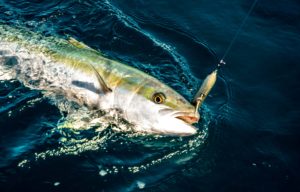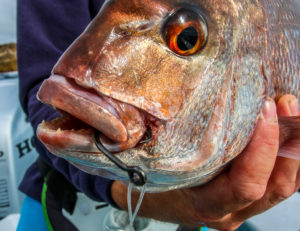
Hooks are a vital connection between fisher and fish. Effectiveness is usually the first consideration when fishers think about what hook is best for their style of fishing, however, there are other important considerations. Do your hooks cause unnecessary damage to fish that you release? A good example of this would be when using treble hooks on stick baits or minnow style lures. Fish can easily take treble hooks down past the mouth and into the gill area. The gills are extremely delicate and any damage is likely to cause death upon release 99% of the time. Other unnecessary damage can be caused to the fish’s eyes or face if the lures has two sets of treble lures i.e. one hook in the belly and one in the tail. Treble hooks are effective at hooking fish but there are other styles that are just as efficient without causing as much harm to fish that are to be released. Single in-line hooks are a good alternative to treble hooks.
Assist hooks, which you usually find on slow jig or inchiku style jigs, are often smaller and rigged in a set of doubles. They are predominantly hidden or wrapped with some style of skirt. These are specifically designed to catch the fish in the lips, jaw or face as it lunges for the lure. These hooks are seldom if ever swallowed or taken into the gill area and smaller sizes are good.
They can be dangerous for the fisher though when a fish is flapping around and one hook is free, swinging around wildly. If this is happening the safest approach is to net the fish (using a rubber mesh net) and use a pair of pliers to unhook the fish. Pliers are good to unhook fish whenever you are using assist hooks as it reduces the risk to the fisher.
Fishing with live baits requires stronger styles of hooks, simply because the species of fish tend to be large and powerful (i.e. kingfish). These hooks tend to be short shanked and straight or circle style hooks are commonly used. Circle hooks are also a great choice for bait fishing for smaller species like snapper and kahawai or trevally and blue cod.

We would recommend using circle style hooks so that any fish caught are more likely to be lip hooked and can be safely released if the fisher wishes to or if the fish is undersized. If you are using non-circle style hooks, we would recommend using a large live bait so that undersized fish (eg kingfish under 75cm) will be less likely to get hooked.
Some countries in central South America have made it illegal to use anything except circle hooks when targeting game fish with bait, to help protect the lucrative sport fishery. These are high value fisheries because the tourism dollars generated are far greater than killing the fish for meat, and nearly all fish are released to maintain the fishery.
Whatever hooks you use, crush the barbs so it is relatively easy to remove the hook. Untold damage is caused by people squeezing the fish and its internal organs during the process to unhook it. Barbless hooks are also a friendly hook to remove from your body parts as your skin won’t have to painfully stretch very far as it is removed.


